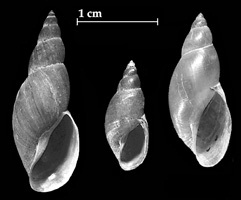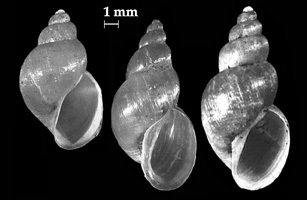Freshwater snails » Shell shape » Shell taller than wide » Dextral shell » Family: Lymnaeidae (1) » Lymnaeidae with short spires (2) » Lymnaeidae with tall spires (3) » Lymnaeidae with tall spires (4) » Lymnaeidae with tall spires (5> »
The shells of this family do not possess an operculum. Many empty freshwater snail shells may be found without an operculum. If your specimen does not have an operculum and does not match the shape and/or descriptions on the following pages, please go back and try the group with an operculum.

Lymnaea fusca
(C. Pfeiffer, 1821)
Lymnaea fusca (C. Pfeiffer, 1821)
Description: The shell is conical, thick-walled, and sometimes has strong longitudinal and spiral sculpturing. It is brown in colour and formed of 6 gradually increasing whorls, the last of which forms about two-thirds of the height. The lip is laid back so as to completely close the umbilicus. The mouth aperture is roughly oval in shape.
Size: Height: 9 – 26 mm. Breadth: 4.3 – 11 mm. (mean 13.9 mm. x 6.7 mm.)
Habitat: It inhabits marshes, ponds, ditches etc., often being found out of water around the margins of rivers or lakes prone to summer dessication. It is common throughout Britain, becoming rarer in the north and west of Scotland.
Carr & Killeen (2003) introduced Lymnaea fusca (C. Pfeiffer, 1821) to the British list as Stagnicola fuscus and it appears to be the commonest segregate of L. palustris in Britain and Ireland. Subsequent taxonomic revisions have resulted in the present name being adopted. It is therefore included in this guide, whereas the "traditional" L. palustis is omitted from the key because dissection is required to verify the species.
Details of internal anatomy are provided by Carr & Killeen Journal of Conchology 38: 7-21.

Galba truncatula
(Müller, 1774)
Galba truncatula (Müller, 1774)
Description: The shell is somewhat elongated and conical, and is rather thin walled. It is pale horn coloured, with 5 - 6 whorls. The spire tapers evenly towards the apex. The mouth aperture is slightly less than half the height of the shell. The suture is deep so that the whorls appear turreted on top. The umbilicus is small but may just be seen.
Size: Height: 8 – 12 mm. Breadth: 4 – 6 mm.
Habitat: It is amphibious and is frequently found out of the water, in marshes and water meadows, as well as on wet mud by rivers and canals, and in shallow well-aerated ponds and lakes.
